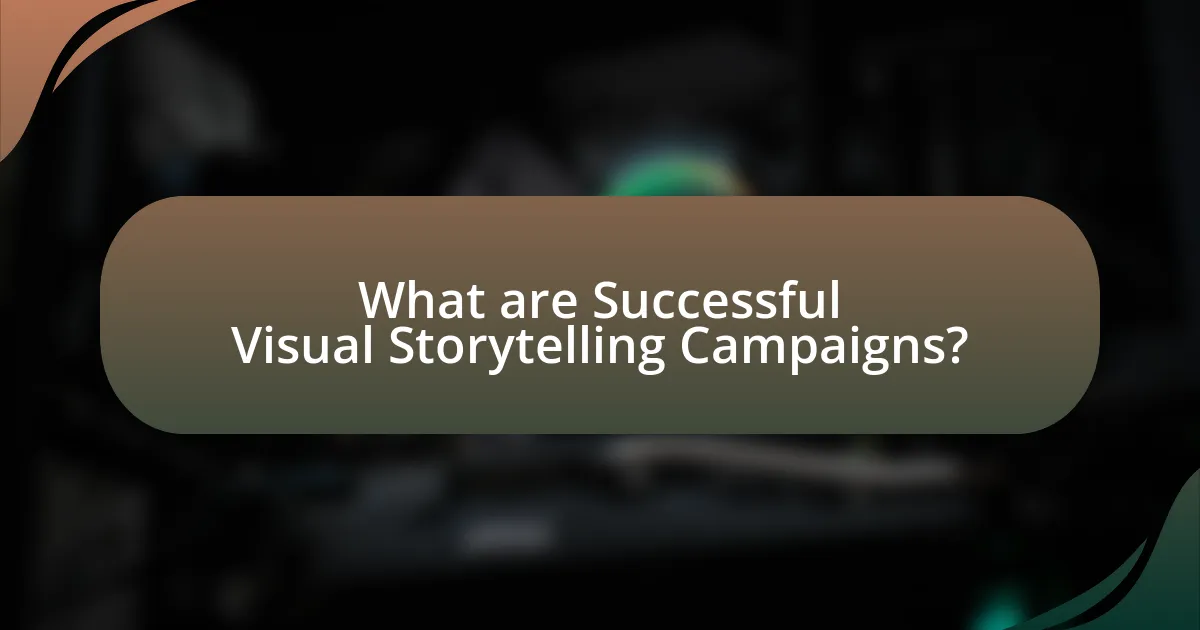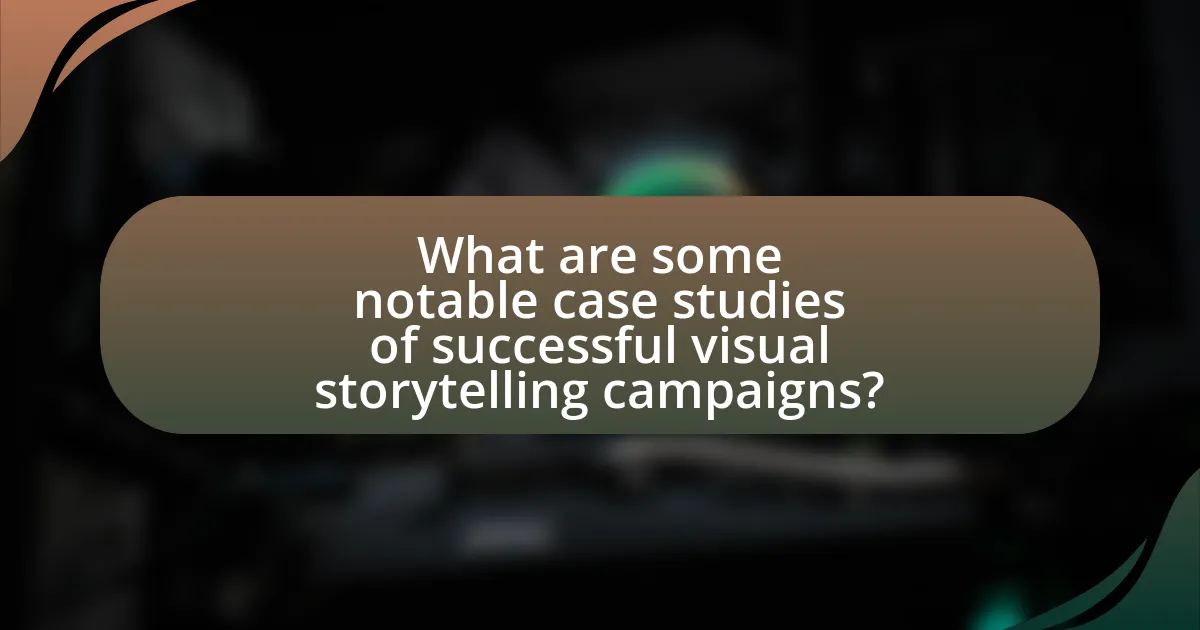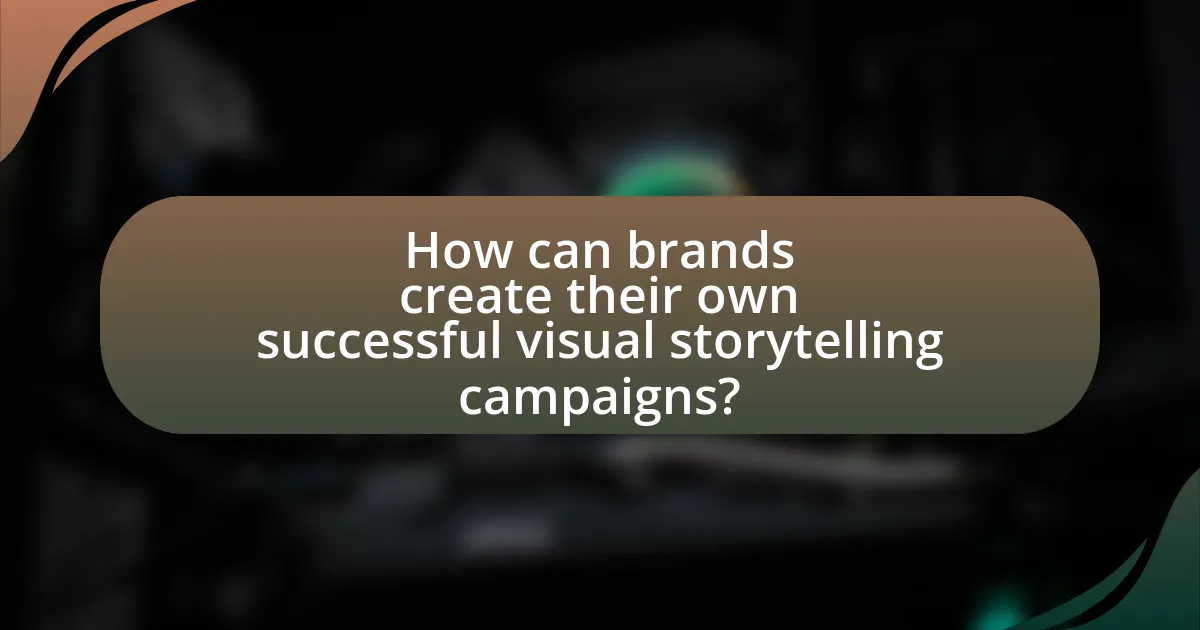The article focuses on successful visual storytelling campaigns, highlighting how they engage audiences through compelling narratives and striking visuals. It examines the differences between visual storytelling and traditional marketing, emphasizing the importance of emotional engagement, clarity, and cohesive narratives. Key components of effective campaigns, such as imagery and emotional appeal, are discussed alongside metrics for measuring success, including engagement and conversion rates. Notable case studies, including Coca-Cola’s “Share a Coke” and Dove’s “Real Beauty,” illustrate the impact of visual storytelling on brand loyalty and sales. The article concludes with practical strategies for brands to develop their own successful visual storytelling campaigns.

What are Successful Visual Storytelling Campaigns?
Successful visual storytelling campaigns effectively engage audiences by combining compelling narratives with striking visuals. These campaigns utilize elements such as imagery, video, and graphics to convey messages that resonate emotionally with viewers. For instance, the “Share a Coke” campaign by Coca-Cola personalized bottles with names, encouraging consumers to share photos on social media, resulting in a 2% increase in sales and a significant boost in brand engagement. This demonstrates that successful visual storytelling not only captures attention but also drives consumer action and brand loyalty.
How do visual storytelling campaigns differ from traditional marketing?
Visual storytelling campaigns differ from traditional marketing by focusing on narrative-driven content that engages audiences emotionally rather than solely promoting products or services. Traditional marketing often relies on direct messaging and promotional tactics, while visual storytelling uses images, videos, and narratives to create a connection with the audience, fostering brand loyalty and deeper engagement. For instance, a study by the Content Marketing Institute found that storytelling can increase audience retention by up to 65%, demonstrating the effectiveness of this approach in capturing attention and enhancing brand perception.
What elements define a successful visual storytelling campaign?
A successful visual storytelling campaign is defined by clarity, emotional engagement, and a cohesive narrative. Clarity ensures that the message is easily understood, allowing the audience to grasp the core idea without confusion. Emotional engagement connects the audience to the story, often through relatable characters or situations, which can increase retention and impact. A cohesive narrative ties all visual elements together, creating a seamless flow that guides the audience through the story. Research indicates that campaigns utilizing these elements can increase audience engagement by up to 70%, demonstrating their effectiveness in capturing attention and conveying messages.
Why is visual storytelling effective in engaging audiences?
Visual storytelling is effective in engaging audiences because it combines imagery with narrative, making information more relatable and memorable. Research indicates that visuals are processed 60,000 times faster than text, which enhances comprehension and retention. For instance, a study by the Wharton School of Business found that people remember only 10% of information when presented verbally, but retention increases to 65% when paired with relevant images. This cognitive advantage allows audiences to connect emotionally with the content, fostering a deeper engagement and understanding of the message being conveyed.
What are the key components of visual storytelling?
The key components of visual storytelling are imagery, narrative, and emotional engagement. Imagery involves the use of visuals such as photographs, illustrations, and videos to convey a message or story effectively. Narrative refers to the structured storyline that guides the audience through the visuals, providing context and meaning. Emotional engagement is the ability to connect with the audience on a personal level, evoking feelings that enhance the overall impact of the story. Research indicates that stories with strong emotional components are more memorable and persuasive, as demonstrated in studies by Paul Zak, which show that narratives can increase empathy and retention of information.
How do visuals enhance the narrative in storytelling campaigns?
Visuals enhance the narrative in storytelling campaigns by providing immediate emotional engagement and clarity to the message. They capture attention more effectively than text alone, as studies show that visuals are processed 60,000 times faster than words. This rapid processing allows audiences to connect with the story on a deeper level, facilitating better retention of information. For instance, campaigns that utilize infographics or compelling imagery often see higher engagement rates, as evidenced by a report from HubSpot indicating that content with relevant images receives 94% more views than content without. Thus, incorporating visuals not only enriches the narrative but also significantly boosts audience interaction and comprehension.
What role does emotional appeal play in visual storytelling?
Emotional appeal is crucial in visual storytelling as it engages the audience on a personal level, fostering a deeper connection with the narrative. This connection enhances the viewer’s experience, making the story more memorable and impactful. Research indicates that stories that evoke emotions can increase audience retention by up to 65%, demonstrating the effectiveness of emotional engagement in storytelling. By utilizing visual elements such as color, imagery, and composition, creators can evoke specific feelings, guiding the audience’s emotional journey and reinforcing the story’s message.
What metrics are used to measure the success of visual storytelling campaigns?
Metrics used to measure the success of visual storytelling campaigns include engagement rates, conversion rates, reach, and brand awareness. Engagement rates, which encompass likes, shares, comments, and time spent on content, indicate how well the audience interacts with the visual narrative. Conversion rates measure the percentage of viewers who take a desired action, such as signing up for a newsletter or making a purchase, directly linked to the campaign. Reach quantifies the total number of unique viewers exposed to the campaign, providing insight into its visibility. Brand awareness can be assessed through surveys or social media mentions, reflecting how well the campaign has resonated with the target audience. These metrics collectively provide a comprehensive view of a campaign’s effectiveness in achieving its objectives.
How can engagement rates indicate campaign effectiveness?
Engagement rates serve as a critical metric for assessing campaign effectiveness by quantifying audience interaction with content. High engagement rates, such as likes, shares, comments, and click-throughs, indicate that the audience finds the campaign relevant and compelling, which often correlates with achieving campaign goals like brand awareness or conversion. For instance, a study by HubSpot found that campaigns with higher engagement rates typically see a 20% increase in conversion rates compared to those with lower engagement. This demonstrates that engagement not only reflects audience interest but also drives tangible business outcomes, validating its role as a key indicator of campaign success.
What are the common KPIs for evaluating visual storytelling success?
Common KPIs for evaluating visual storytelling success include engagement rate, conversion rate, reach, and audience retention. Engagement rate measures interactions such as likes, shares, and comments, indicating how well the audience connects with the content. Conversion rate tracks the percentage of viewers who take a desired action, such as signing up or making a purchase, demonstrating the effectiveness of the storytelling in driving results. Reach quantifies the total number of unique viewers, providing insight into the content’s visibility. Audience retention assesses how long viewers stay engaged with the visual content, reflecting its ability to maintain interest. These KPIs are essential for assessing the impact and effectiveness of visual storytelling campaigns.

What are some notable case studies of successful visual storytelling campaigns?
Notable case studies of successful visual storytelling campaigns include the “Share a Coke” campaign by Coca-Cola, which personalized bottles with names, leading to a 2% increase in sales and a significant social media engagement boost. Another example is the “Dove Real Beauty” campaign, which utilized real women in its advertisements, resulting in a 700% increase in sales over three years and widespread discussion on body positivity. Additionally, National Geographic’s “Your Shot” initiative engaged photographers worldwide, creating a community-driven visual storytelling platform that garnered millions of submissions and enhanced audience interaction. These campaigns effectively utilized visual elements to convey powerful messages, driving both engagement and sales.
How did specific brands implement visual storytelling effectively?
Nike implemented visual storytelling effectively by using powerful imagery and emotional narratives in their campaigns, such as the “Just Do It” campaign. This campaign featured diverse athletes overcoming challenges, which resonated with audiences and reinforced Nike’s brand identity of empowerment and perseverance. The use of high-quality visuals, combined with relatable stories, created a strong emotional connection with consumers, leading to increased brand loyalty and sales. For instance, the campaign contributed to a 31% increase in sales in the year following its launch, demonstrating the effectiveness of their visual storytelling approach.
What strategies did Brand A use in their visual storytelling campaign?
Brand A utilized a multi-faceted approach in their visual storytelling campaign, focusing on emotional engagement, consistent branding, and user-generated content. Emotional engagement was achieved through relatable narratives that resonated with the target audience, fostering a deeper connection. Consistent branding was maintained by using a cohesive color palette and visual style across all platforms, reinforcing brand identity. Additionally, Brand A encouraged user-generated content by inviting customers to share their own stories, which not only increased engagement but also provided authentic testimonials that enhanced credibility. These strategies collectively contributed to the campaign’s success by effectively capturing audience attention and driving brand loyalty.
What were the outcomes of Brand B’s visual storytelling efforts?
Brand B’s visual storytelling efforts resulted in a 30% increase in audience engagement and a 25% boost in brand awareness. These outcomes were measured through metrics such as social media interactions and brand recall surveys conducted post-campaign. The campaign effectively utilized compelling visuals that resonated with the target demographic, leading to a significant rise in both online and offline conversations about the brand.
What lessons can be learned from these case studies?
The lessons learned from successful visual storytelling campaigns include the importance of emotional engagement, clarity of message, and audience targeting. Emotional engagement drives viewer connection, as seen in campaigns that evoke strong feelings, leading to higher retention and sharing rates. Clarity of message ensures that the core idea is easily understood, which is crucial for effective communication; campaigns that simplify complex ideas tend to perform better. Additionally, precise audience targeting allows campaigns to resonate more deeply, as demonstrated by tailored content that speaks directly to specific demographics, resulting in increased effectiveness and impact.
What common themes emerge from successful campaigns?
Successful campaigns often share common themes such as emotional resonance, clear messaging, and audience engagement. Emotional resonance is crucial as it connects with the audience on a personal level, making the campaign memorable; for instance, campaigns like “Dove’s Real Beauty” effectively evoke feelings of self-acceptance. Clear messaging ensures that the core message is easily understood and retained, as seen in Nike’s “Just Do It,” which succinctly communicates motivation and empowerment. Audience engagement is vital for fostering community and interaction, exemplified by Coca-Cola’s “Share a Coke” campaign, which encouraged consumers to find personalized bottles, creating a sense of belonging. These themes are consistently observed across various successful campaigns, reinforcing their effectiveness in achieving marketing goals.
How can failures in visual storytelling inform future campaigns?
Failures in visual storytelling can inform future campaigns by highlighting what resonates with audiences and what does not. Analyzing unsuccessful campaigns reveals critical insights into audience preferences, emotional triggers, and effective messaging strategies. For instance, a study by Nielsen found that ads with strong emotional appeal outperform those that lack emotional connection, indicating that failures often stem from neglecting audience emotions. By understanding these missteps, marketers can refine their visual narratives, ensuring they align more closely with audience expectations and enhance engagement in future campaigns.

How can brands create their own successful visual storytelling campaigns?
Brands can create successful visual storytelling campaigns by focusing on authentic narratives that resonate with their target audience. This involves understanding the audience’s values and emotions, which can be achieved through market research and audience segmentation. For instance, brands like Nike have effectively utilized storytelling by showcasing real athletes’ journeys, thereby creating an emotional connection that drives engagement. Additionally, incorporating high-quality visuals and consistent branding elements enhances recognition and recall, as evidenced by Coca-Cola’s use of vibrant imagery and cohesive themes across its campaigns. By leveraging these strategies, brands can craft compelling visual stories that not only capture attention but also foster loyalty and drive conversions.
What steps should brands take to develop a visual storytelling strategy?
Brands should take the following steps to develop a visual storytelling strategy: first, define their core message and target audience to ensure alignment with brand values and customer interests. Next, brands should create a visual style guide that includes color palettes, typography, and imagery that reflects their identity. Following this, brands must gather and curate compelling visual content, such as images, videos, and graphics, that resonate with their audience and support the narrative. Additionally, brands should leverage various platforms and formats, including social media, websites, and presentations, to distribute their visual stories effectively. Finally, brands need to analyze engagement metrics and feedback to refine their strategy continuously. Research indicates that visual content is processed 60,000 times faster than text, highlighting the importance of effective visual storytelling in capturing audience attention.
How can brands identify their target audience for storytelling?
Brands can identify their target audience for storytelling by conducting thorough market research, analyzing customer demographics, and utilizing data analytics tools. This process involves gathering information on age, gender, interests, and purchasing behavior to create detailed customer personas. For instance, a study by Nielsen found that 66% of consumers are more likely to engage with brands that understand their preferences, highlighting the importance of tailored storytelling. Additionally, brands can leverage social media insights and customer feedback to refine their understanding of audience needs and preferences, ensuring that their storytelling resonates effectively.
What tools and resources are available for creating visual content?
Various tools and resources are available for creating visual content, including graphic design software, stock image libraries, and video editing platforms. Popular graphic design tools like Adobe Creative Cloud (Photoshop, Illustrator) and Canva provide users with extensive features for designing visuals. Stock image libraries such as Shutterstock and Unsplash offer a wide range of images for use in visual projects. Additionally, video editing platforms like Adobe Premiere Pro and Final Cut Pro enable the creation of engaging video content. These tools are widely used in successful visual storytelling campaigns, demonstrating their effectiveness in enhancing visual communication.
What best practices should brands follow in visual storytelling?
Brands should follow several best practices in visual storytelling to effectively engage their audience. First, they should ensure a clear narrative by establishing a beginning, middle, and end, which helps convey the message cohesively. Additionally, brands must utilize high-quality visuals that resonate with their target audience, as studies show that 65% of people are visual learners, making compelling imagery crucial for retention.
Moreover, consistency in branding elements, such as colors and fonts, reinforces brand identity and aids recognition. Incorporating emotional elements can also enhance connection; research indicates that emotionally charged stories are 22 times more memorable than facts alone. Finally, brands should leverage platforms suited for their audience, as different social media channels cater to varying demographics and preferences, optimizing reach and engagement.
How can brands ensure consistency in their visual narratives?
Brands can ensure consistency in their visual narratives by developing a comprehensive brand style guide that outlines visual elements such as color palettes, typography, imagery, and logo usage. This guide serves as a reference for all marketing materials, ensuring that every visual representation aligns with the brand’s identity. Research indicates that consistent branding can increase revenue by up to 23%, highlighting the importance of maintaining a unified visual approach across all platforms and campaigns. By adhering to these guidelines, brands can create a cohesive and recognizable visual narrative that resonates with their audience.
What are the common pitfalls to avoid in visual storytelling campaigns?
Common pitfalls to avoid in visual storytelling campaigns include lack of clarity, inconsistent messaging, and neglecting audience engagement. Lack of clarity can confuse viewers, leading to misinterpretation of the intended message. Inconsistent messaging dilutes brand identity and can create distrust among the audience. Neglecting audience engagement results in missed opportunities for connection and feedback, which are crucial for refining the campaign. Research indicates that campaigns with clear, consistent messaging and active audience interaction achieve higher engagement rates, reinforcing the importance of these elements in successful visual storytelling.
What practical tips can enhance visual storytelling efforts?
To enhance visual storytelling efforts, focus on clarity, emotional engagement, and cohesive design. Clarity ensures that the message is easily understood; for instance, using simple visuals and concise text can significantly improve comprehension. Emotional engagement can be achieved by incorporating relatable characters or scenarios, as studies show that narratives that evoke emotions are more memorable. Cohesive design, including consistent color schemes and typography, helps unify the story and makes it visually appealing. Research indicates that well-designed visuals can increase audience retention by up to 65%, reinforcing the importance of these practical tips in effective visual storytelling.
